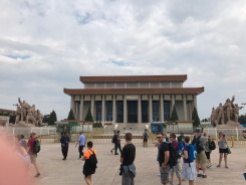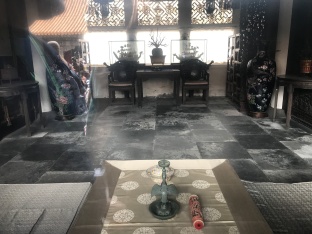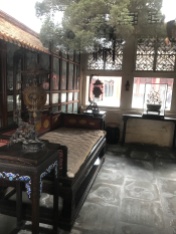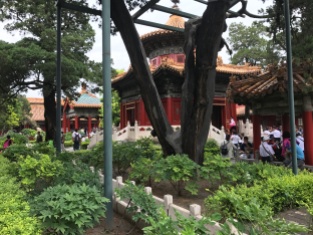Tiananmen Square
Our first stop today was Tiananmen Square, the site of the famous 1989 protest in which university students demonstrated, resulting in hundreds of civilian deaths. It’s tumultuous history creates an atmosphere of both awe and oppression despite its vast expanse. The square is enormous, large enough to hold 1 million people. Multiple buildings outline the square, including the entrance, the army office, a government conference building – in which a yearly conference happens bringing together all of the local governments around the nation to report to the central government and plan for the coming year – monument to the people’s hero – for the army heroes – the national museum, and Chairman Mao’s mausoleum – his body is entombed in a crystal casket inside. As you can see in the photos below, a painting of 1967 Chairman Mao hangs above the entrance to the forbidden city. They call it “Mona Lisa Mao” – anywhere you walk in the square his eyes follow you. He is always watching.
Tiananmen Square means Heavenly Peace Gate Square it marks the entrance to the Forbidden City. Every morning at sunrise there is a flag raising ceremony and every evening at sundown there is another ceremony for lowering the flag. Also, each day, a different group of students – members of the pioneers – stand on the memorial steps out of honor. This place is one of pride and respect in China. Citizens visit it daily and show their pride in their country and their culture.
The Forbidden City
The Forbidden City was home to China’s Emperors beginning during the Ming Dynasty through the final Emperor during the Ch’ing Dynasty. A total of 24 Emperors lived in the Forbidden City, with final Emperor living there until 1924. It is massive, with only 20% of the city open to the public. It was built in 1420 during the Ming dynasty when the capital was moved to Beijing. It is now the Palace Museum.
The original building actually burnt down in 1421. Upon reconstruction, they added the giant copper cauldrons, which they would keep filled with water to fight fires should another occur. There are several cauldrons surrounding the first three buildings, but still would not really stop a fire. The idea was that if the cauldrons existed, there would be no fire. Women were not allowed in the outer corridor. The Meridian Gate is the entrance to the compound and had two entrances, one for women and one for men. Both entrances are marked by a statue of lion. On the men’s side, the lion plays with a ball under his right paw and on the left the plays with her baby under her left paw.
In the outer corridor, there are three buildings (see picture above with the small building in the center). The building on the right is for the Hall of Supreme Harmony. Inside sits the dragon chair. Dragon means Emperor, so this was essentially the throne room. The building on the left was used for testing. The Emperor would test potential officials. The middle room was strictly for changing. The Emperor used this room to get dressed in proper attire before entering the Hall of Supreme Harmony. It is all extremely grand and opulent. As you enter the outer corridor it is customary to touch the large nobs which adorn the great doors (third line up) for luck and a long life. The buildings were repainted prior to the Beijing Olympics, otherwise they are original – extremely sturdy construction considering these buildings have been standing for nearly 600 years. The Chinese government is dedicated to preserving their nation’s history. It’s breathtaking.
*Note: I just happened upon the cat in the upper right picture above. He was resting in the afternoon son. Clearly a stray, he still appeared well fed and content, if not a bit mangy. So cute. In the Modern Art Zone I saw some stray dogs who were equally as cute lounging outside a couple of cafes.
The next section of the Forbidden City was the inner corridor which housed the Emperor’s concubines. According to law, he was allowed 3000 concubines. These girls were usually chosen between the ages of 13 and 16 and brought to the palace for the pleasure of the Emperor – he did not get to choose his wife, but he did get to choose his concubines. Each evening, after finishing his daily business, a eunuch would bring him a list of potential partners for the evening and he would simply point to one. The girl would prepare for her visit by bathing and coifing, then she would remove all of her clothing and be wrapped up in a silk rug and brought to the Emperor. She was brought to him in this way to ensure she did not have any weapons with her.
One very famous and extremely ambitious concubine was known as the Dragon Lady. She befriended the eunuchs and as such they would place her name on the scroll numerous times. Because she was able to visit the Emperor more often than the others, she bore him a son. That son eventually became Emperor at the tender age of 6. He later died of smallpox at 19 because the Dragon Lady arranged for him to have the wrong medicine. She then got her nephew, who was only 4 to be Emperor – allowing her to control everything. It’s quite a story and one which continues with the summer palace below.
The photos above are from the Imperial Garden. It’s incredibly beautiful and peaceful. The concubines often spent there time there. It’s serene and has natural rock formations unlike anything I’ve seen.
*Note: The doorways all have a high lip, making you step high to walk through. You can see one in the doorway picture above. The purpose of the lip is to keep the devil out. Just my kind of creepy detail.
The Summer Palace
The Summer Palace is possibly one of the most beautiful sites in Beijing. The lake is serene and the view from the shore on a sunny day is magical. The Emperor summered at this palace and often held celebrations here. It was at this site the Dragon Lady’s nephew, the then Emperor, organized a revolution against her in 1898. Unfortunately, she won and had her nephew arrested and imprisoned inside the Summer Palace. He was forced to stay there, without seeing anyone for 10 years. They say he stayed there just waiting to die. The Dragon Lady even built a brick wall inside the door so no one could see in and to prevent her nephew from seeing out. When the Emperor finally died in 1908, the Dragon Lady found a young boy of only 3 to become the next Emperor. She was ruthless.
At the front of the Summer Palace there is a statue that is a mixture of several animals – a dragon, deer, and a lion. This statue stands for justice – interesting considering the history of the place. Additionally, in front of the main hall (top left in pictures above) there are four statues, two dragons and two peacocks. The Dragon Lady had the Peacocks placed closer to the door to show that she was really in charge.
The Summer Palace has the longest corridor (see above pictures, bottom right), measuring 728 meters from beginning to end. Along the corridor, on the ceiling beams, are painted 14,000 paintings. Along the side and at the end of the corridor is the lake. When you reach the very end there is a marble boat (see below, top left). This boat was the Dragon Lady’s favorite place to sit and listen to the rain.
We ended our visit to the Summer Palace with a dragon boat ride across the lake. The sun was bright and the view spectacular. It was a wonderful way to end a busy and very interesting day. There is so much to describe, what I’ve provided here only scratches the surface. Thanks for following along on this journey with me.






















































Another great day! So wish I were in your hip pocket! Cary and Becky promise to take me to this magical country somaday! So much to see. xoxoxo
LikeLike
I just updated it again. I’ll be posting about the Great Wall tomorrow – now that was spectacular!
LikeLike